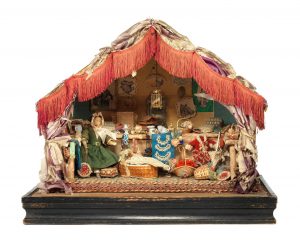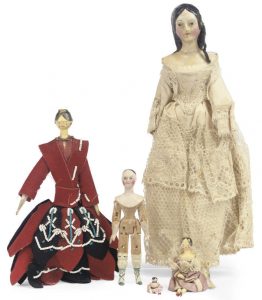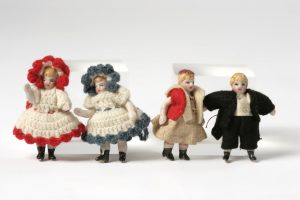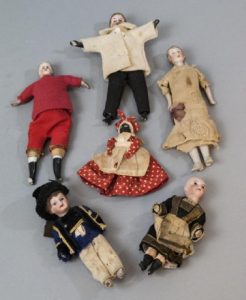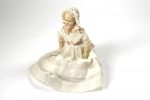DOLLS HOUSE DOLLS
Miniature homes, furnished with domestic articles and resident inhabitants, both people and animals, have been made for thousands of years. The earliest known examples were found in the Egyptian tombs of the Old Kingdom, created nearly five thousand years ago. These wooden models of servants, furnishings, boats, livestock and pets placed in the Pyramids almost certainly were made for religious purposes.
The earliest known European dollhouses were the baby houses from the 16th century, which consisted of cabinet display cases made up of individual rooms. Dollhouses of this period showed idealized interiors complete with detailed furnishings and accessories. The cabinets were built by hand with architectural details, filled with miniature household items and were solely intended for adults. They were off-limits to children, not because of safety concerns for the child but for the dollhouse.
The earliest “baby house” was made in 1557-8 for Albert V, Duke of Bavaria. This was popularly known a the Munich Baby House. The term “baby” continued to be used to describe hand-built houses, chiefly in Germany, the Netherlands and Britain until the eighteenth century.
Dolls houses also had another purpose, besides being used as displays for miniatures, they provided an excellent visual aid for servants and young women. They were often used as instructional aids for girls learning domestic skills in the 1600s and 1700s.
The baby houses of the 17th and 18th centuries, and the toy dollhouses of the 19th and early 20th century rarely had uniform scales, even for the features or contents of any one individual house. Although a number of manufacturers made lines of miniature toy furniture in the 19th century, these products were not to a strict scale.
Germany produced the most prized dollhouses and doll house miniatures up until World War I. Notable German miniature companies included Märklin, Rock and Graner and others. Their products were not only avidly collected in Central Europe, but regularly exported to Britain and North America. Germany’s involvement in WWI seriously impeded both production and export. New manufacturers in other countries arose. Miniature dolls to fit these houses come in many forms from simple wooden peg dolls to fine bisque heads.
Children’s play dollhouses from most of the 20th and 21st centuries are 1:18 or two third inch scale (where 1 foot is represented by 2/3 of an inch). Common brands include Lundby (Sweden), Renwal, Plasco, Marx, Petite Princess, and T. Cohn (all American) and Caroline’s Home, Barton, Dol-Toi and Tri-ang (English). A few brands use 1:16 or 3/4″-scale.
The most common standard for adult collectors is 1:12 scale, also called 1″ or one inch scale (where 1 foot is represented by 1 inch.) Among adult collectors there are also smaller scales which are much more common in the United States than in Britain. 1:24 or half inch scale (1 foot is 1/2″) was popular in Marx dollhouses in the 1950s but only became widely available in collectible houses after 2002, about the same time that even smaller scales became more popular, like 1:48 or quarter inch scale (1 foot is 1/4″) and 1:144 or “dollhouse for a dollhouse” scale.

